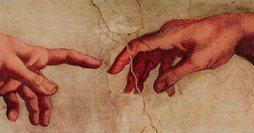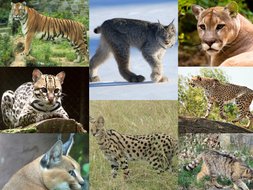KEPLER-SCIENCE
BioLogos - logical?
Some theologians and scientists want to reconcile the evolution-theory with the Bible - we call this theïstic evolution or evolutionary creation: it states that creation was done by evolution, God only working in the background - providentially. BioLogos is the main organization that advocates this view.
On this page the scientific arguments found on biologos.org pro (general) generalon are discussed.
Biblical arguments (against theïstic evolution) are discussed on: Bible on Origins.
Forms and structures point to common ancestors?
This is a common argument. We do find a lot of similarities. Skeletons of tetrapods all show variations of the same body plan. At school students are often told about plantigrades (walking on the whole of their feet, like martens and bears), digitigrades (walking on toes, like dogs and cats) and unguligrades (walking on hoofs, like sheep and horses). In principal you can find the same types of bones each of these, but place and size differ. On biologos.org is stated that skeletons don't have to be this way and that this resulted in inefficiency in some cases: how many people do you know with lower-back and knee problems?
What is the value of this argument?
- A common body plan is exactly what can be expected from a Designer, an Architect. Art experts recognise a Rembrandt or a Van Gogh by the 'signature' of the artist - like the way Rembrandt handles the paint brush and uses light in his paintings.
- I believe not all variaties in body plan were present right at the start of creation. There is ample room for variation, development and diversification. This shows in the possibility of speciation: all Cats belong to the same basic type (see picture), but you see diversity in e.g. fur colour, size and suppleness. This originates in the genetic and epi-genetic flexibility, built into this basic type. The same flexibility seems to be available when you do selective breeding with e.g. apples or cows.
- The argument of the lower-back and knee problems points to the Biblical truth of the frustration that came into creation after the Fall. This could have been caused (biologically speaking) by several mechanisms - like in-breeding (that's what is behind selective breeding: certain dog races standard have e.g. too short a nose) or by another form of loss of function - usually by mutations.
Does the fossil record reveal many intermediate species?
Of course we first of all should discuss the origin of the fossil record and the dating of the strata - go to Origins>Strata to know more - but here we will discuss the argument of the intermediate species on the basis of the assumption the evolutionary dating is right. Do we indeed find many intermediate species?
- The Tiktaalik is given as typical example - but the oldest tetrapode fossil is found below the Tiktaalik: imagine you being born before your grandfather...
- A bit the same applies to the Archeopterix, which for a long time was supposed to be the intermediate between Dinosaur and Bird - until first one and then more bird fossils were found in 'older' strata.
- Quite a few complex life forms seem to appear suddenly in the Cambrium (it is called the Cambrium explosion: most of the animal Phyla are already present overthere) - below this layer hardly any fossils are found.
- Look e.g. at the supposed lineage of horses and wonder why the first one has 18 ribs, the Eohippus 15, the Pliohippus 19 and the Equus again 18.
Whale evolution is specified more elaborately. This is supposed to have happened in about 15 million years - not much on evolutionary time scale for so many features that have to change. Let's take a look at some questions about it:
- Evolutionists speak about 'walking whales' because they think the first three or four in line of succession could walk - but they don't look like whales at all - so this name shows bias.
- The only feature that connects the five stages of whale evolution with the real whale, is the involucrum: a small part of the middle ear. That's a very shallow basis to decide on a line of descent.
- Whale ears are - by the way - quite different: their bones need to be isolated from the skull because of the hearing under water. The ear drum needs to be protected from the high pressure (some whales dive very deep).
- The tail in whales is very special (it moves up and down) and is't found in any of the intermediate species.
- Baleen whales don't have teeth at all. The so-called tooth-buds in baleen whales are quite different and there are a lot more than teeth of supposed ancestors (40 pairs in stead of 15 pairs)
- The oldest real whale fossil is older than some of the supposed ancestors.
- Important for whales is the blowhole on top (the nose), but it is clear this blowhole doesn't move upwards at all in this series of supposed ancestors.
For more information on this topic you can use link nr. 1.
The argument of vestigial organs
This argument often is presented alongside the body plan argument. In many organisms organs are found that don't seem to have a function - or changed function. Classical examples are the eyes of blind cave-fish, hip bones in whales and our own appendix and wisdom teeth.
What is the value of this argument?
- An organ losing its function is a form of degeneratron: the use-it-or-lose-it principle. Nothing new comes into existence, so no argument for evolution. The case of the blind cave-fish is very logical (link 4). Wisdom teeth have probably become less important in our days.
- For many so-called vestigial organs a (sometimes very important) function has been discovered. Our appendix is important for our immunity system and probably also is a safe-haven for our colon bacteria - placed very strategically fer both functions: argument for design!
- Speaking about a change in function supposes (rather than proves) evolution.
- The so-called hip bone of whales isn't vestigial: it has a function in defeacation and copulation (it's different in male and female) and doesn't resemble hip bones at all - it also isn't connected to the skeleton.
Links
- Whale evolution discussed by Jonathan Sarfati
- A simple and short video about whale evolution
- More on the blind cave-fish.
- Biogeography: rafting vs continental drift
- More on the homology argument (forms, structures and vestigial organs).
- Also about common design - common descent?
- Bad design as left-overs of evolution?
- What about the fossil record?
Genetic removes all reasonable doubt
On this statement I do agree - but I come to a quite contrary conclusion:
- DNA does show kinship within a Basic Type.
- It also shows similarities in solutions for the same problem in totally different organisms: the signature of the Architect of Life.
- It starts to get confusing if we want to produce family trees for all organisms: they differ a lot for different traits. See also the DNA page.
- Producing new information cannot be accounted for in the evolution process: no good mechanism for macro-evolution has been found as yet.
More can be found on the Origins pages (Biodiversity and Man) and more will follow.
What about biogeography?
Biogeography is about the distribution of species. As is stated on biologos.org: The differences between species on islands compared to mainlands provide a compelling example of evolution.
What is the value of this argument?
- Let's take a look at the example of the at least 56 different species of Honeycreepers on Hawaii which evolved from just one species. I say 'amen' to this: Honeycreepers belong to the same Basic Type (see also Origins>Biodiversity). Especially islands are good candidates for developing new species - and that can happen pretty quickly because already existing gene programs can be used (see more on the DNA page).
- Plate tectonics drove the conitnents and even some islands apart - I agree on that, but use a quite different time scale (see Origins>Strata, especially link nr. 7).
- I also think that the evolution story doesn't give the best explanation of the distribution of species. A paper of Dominic Stratham discusses the problems and gives rafting after the Flood as a better alternative (link nr. 4). A summary is at present only available in Dutch.



